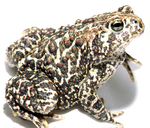|
Anaxyrus hemiophrys (Cope, 1886)
Canadian Toad | family: Bufonidae genus: Anaxyrus |
 © 2011 Richard Sage (1 of 1) |
|
|
|
Description Distribution and Habitat Country distribution from AmphibiaWeb's database: Canada, United States U.S. state distribution from AmphibiaWeb's database: Minnesota, Montana, North Dakota, South Dakota, Wyoming Canadian province distribution from AmphibiaWeb's database: Alberta, Manitoba, Northwest Territories, Saskatchewan
A. hemiophrys occurs in grassland, ponds, potholes, lakes, aspen parkland, streams, areas with soft soil and along the range of the boreal forest regions. Habitat may have a very limited amount of vegetation, or even none at all (Hamilton 1998). Eggs are laid in the shallow water of lakes, ponds, quiet streams, marshes, potholes, and roadside ditches (Stebbins 2003). Life History, Abundance, Activity, and Special Behaviors It feeds on a variety of worms, beetles, and ants (Alberta Government 2002). Breeding season is from May to July, depending on the area. Breeding usually occurs in shallow areas of lakes, ponds or even temporary bodies of water. The female lays a single strand of eggs, totaling up to about 7000 eggs. Depending upon the temperature of the water, the eggs will hatch 3-12 days later (Alberta Government 2002). Canadian Toads have some defensive mechanisms to divert predators. When they are in danger, they increase their body size by inflating their bodies, or "play dead" when in immediate danger. Sometimes they startle their predators by crying loudly. They can also produce a thick white noxious secretion from the parotoid glands on the sides of their necks (Green 1997). Trends and Threats Possible reasons for amphibian decline General habitat alteration and loss
References
Alberta Government (2002). Amphibians of Alberta. Crown Copywrite, http://www3.gov.ab.ca/srd/fw/amphib/ct.html. Blackburn, L., Nanjappa, P., and Lannoo, M. J. (2001). An Atlas of the Distribution of U.S. Amphibians. Ball State University, Muncie, Indiana. Greeen, D.M., and Pustowka, C. (1997). ''Correlated morphological and allozyme variation in the hybridizing toads Bufo americanus and Bufo hemiophrys.'' Herpetologica, 53, 218-228. Hamilton, I.M., Skilnick, J.L., Troughton, H., Anothony, P., Russell, G., and Powell, L. (1998). ''Status of the Canadian Toad (Bufo hemiophrys) in Alberta.'' Alberta Environmental Protection, Wildlife Management Division, and the Alberta Conservation Association, 12, 8-21. Stebbins, R. C. (2003). Western Reptiles and Amphibians, Third Edition. Houghton Mifflin, Boston. Trenham, P. C., and Marsh, D. M. (2001). ''Amphibian translocation programs: reply to Seigel and Dodd.'' Conservation Biology, 16(2), 555-556. Originally submitted by: Zaina Khan (first posted 2001-04-25) Edited by: Tate Tunstall, Peera Chantasirivisal, Kellie Whittaker (2012-08-15) Species Account Citation: AmphibiaWeb 2012 Anaxyrus hemiophrys: Canadian Toad <https://amphibiaweb.org/species/192> University of California, Berkeley, CA, USA. Accessed Jun 1, 2025.
Feedback or comments about this page.
Citation: AmphibiaWeb. 2025. <https://amphibiaweb.org> University of California, Berkeley, CA, USA. Accessed 1 Jun 2025. AmphibiaWeb's policy on data use. |




 Map of Life
Map of Life